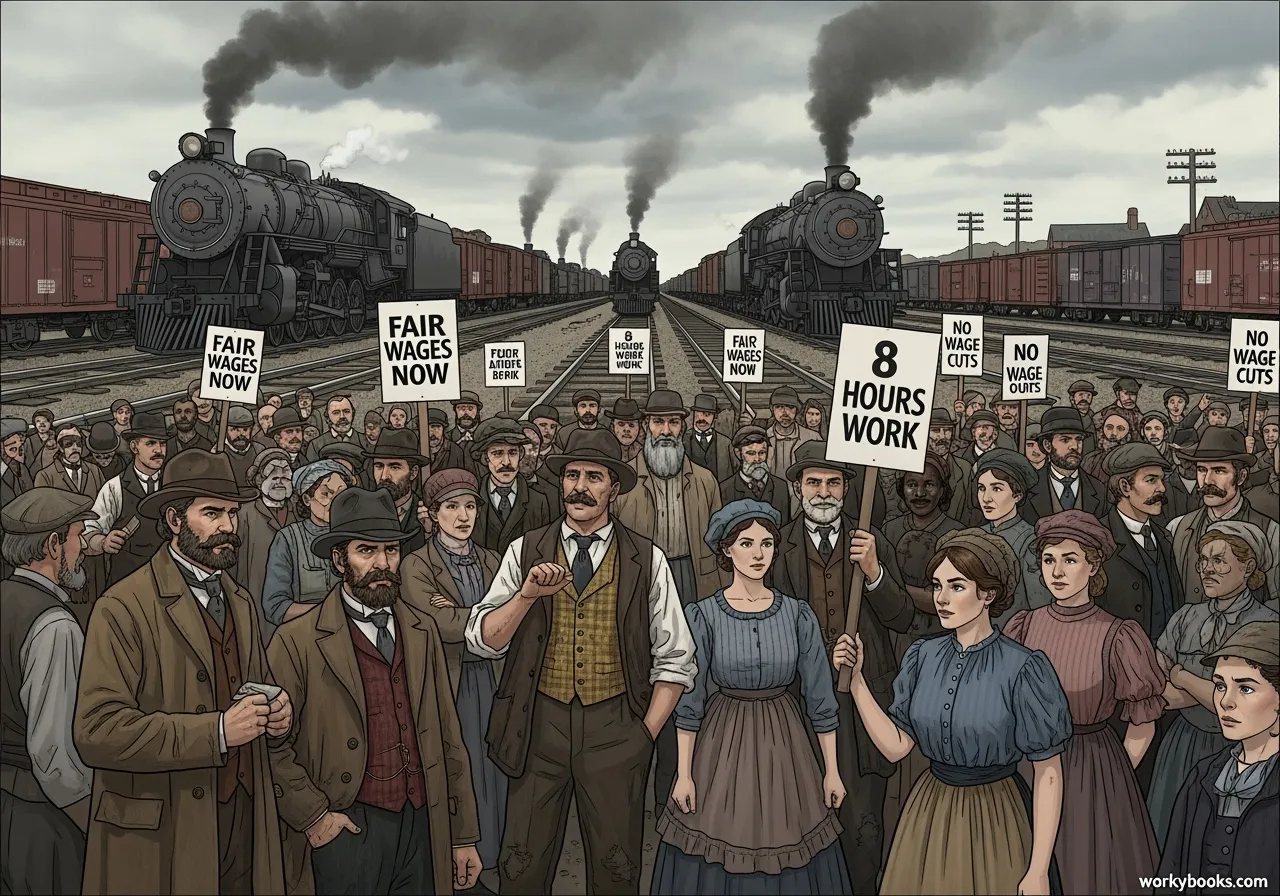Great Railroad Strike of 1877
Discover how a major labor strike changed American history and workers' rights forever!
What Was the Great Railroad Strike of 1877?

The Great Railroad Strike of 1877 was a major event in American history when railroad workers across the United States went on strike to protest unfair treatment and pay cuts. This was the first nationwide strike in American history and involved thousands of workers.
The strike began in July 1877 and spread quickly across the country, affecting many railroad companies. It showed how important railroad workers were to the American economy and how workers could organize to demand better conditions.
Did You Know?
The Great Railroad Strike of 1877 was the first nationwide labor strike in United States history! About 100,000 workers participated across multiple states.
Causes of the Strike

Several factors led to the Great Railroad Strike of 1877:
Wage Cuts: After the Panic of 1873 (a major economic depression), railroad companies cut workers' wages multiple times. By 1877, many workers had seen their pay reduced by 35-50%.
Dangerous Working Conditions: Railroad work was extremely dangerous with long hours and frequent accidents. Workers had little protection or compensation for injuries.
Lack of Rights: Workers had no job security and could be fired at any time. They also had no legal way to complain about unfair treatment.
Economic Depression
The Panic of 1873 caused financial hardship for many Americans
Wage Cuts
Railroad companies reduced workers' pay by up to 50%
Worker Frustration
Workers felt they had no other way to protest unfair treatment
How the Strike Spread

The strike began on July 14, 1877, when workers for the Baltimore and Ohio Railroad in Martinsburg, West Virginia, refused to work after their pay was cut for the second time in a year.
The strike quickly spread along the railroad lines:
Workers for the B&O Railroad walk off the job, stopping all train traffic
Strike spreads to Baltimore where violent clashes occur between strikers and militia
The strike reaches Pittsburgh where workers burn railroad property
The strike spreads to Chicago, St. Louis, and other major cities
Within two weeks, the strike had spread to 17 states and involved approximately 100,000 workers. Rail traffic was disrupted across much of the country.
Government Response

The strike prompted a strong response from government officials and business leaders:
President Rutherford B. Hayes sent federal troops to several cities to restore order and protect railroad property. This was the first time the U.S. army was used to break a labor strike.
State Militias were called out in multiple states. In some cases, these militias refused to fire on the strikers, showing that many ordinary people supported the workers.
Violence Erupted in several cities. The most serious violence occurred in Pittsburgh, where strikers burned more than 2,000 railroad cars and several buildings after militia killed about 20 people.
Important Note
About 100 people were killed and many more injured during the strike. The violence showed how serious the conflict between workers and business owners had become.
Impact of the Strike

Although the strike was eventually broken by force, it had lasting effects on American society:
Labor Movement Growth
The strike inspired workers to organize and form stronger labor unions
Public Awareness
Americans became more aware of workers' struggles and the power of big corporations
Government Policies
The strike led to discussions about workers' rights and government's role in labor disputes
The Great Railroad Strike of 1877 marked the beginning of a new era in American labor relations. It showed that workers could organize on a national scale and that labor disputes could have serious consequences for the entire country.
Great Railroad Strike Quiz
Test your knowledge about the Great Railroad Strike of 1877! Answer all 5 questions to see how much you've learned.
Frequently Asked Questions
Here are answers to common questions about the Great Railroad Strike of 1877:
Great Railroad Strike Trivia
Discover interesting facts about the Great Railroad Strike of 1877!
First National Strike
The Great Railroad Strike of 1877 was the first nationwide labor strike in United States history, setting a precedent for future labor movements.
Economic Context
The strike occurred during the Long Depression (1873-1879), one of the worst economic crises in U.S. history, which began with the Panic of 1873.
Military Response
President Hayes sent federal troops to multiple cities, marking the first time the U.S. army was used to break a labor strike.
Labor Movement Catalyst
Despite its failure, the strike inspired the formation of stronger labor unions, including the Knights of Labor and later the American Federation of Labor.


